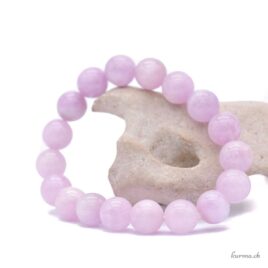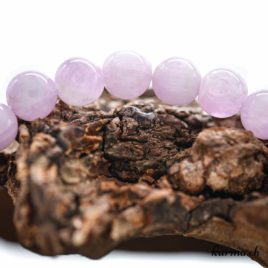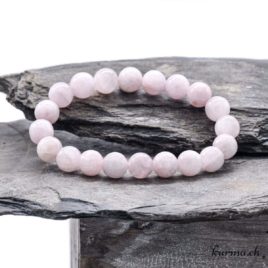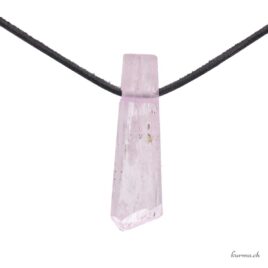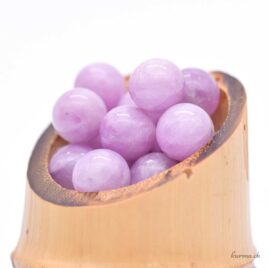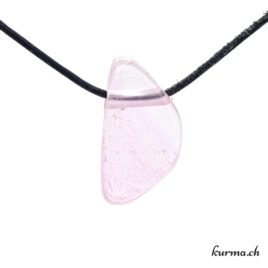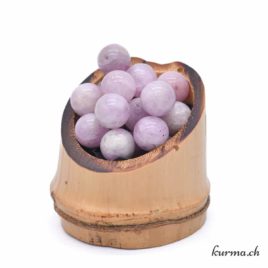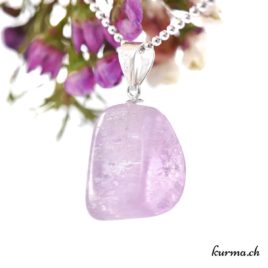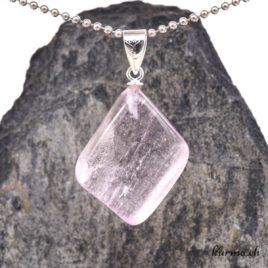Kunzite
gemstones, bracelets, pierced stone pendants, beads
Kunzite, a pink to violet variety of Spodumene, is a stone that opens the heart to love in lithotherapy.
It dispels negativity and promotes optimism, empathy and comfort.
What are the virtues and properties of Kunzite in lithotherapy?
Kunzite symbols
Discovered in California in 1902, Kunzite owes its name to mineralogist George Frederick Kunz.
This silicate mineral has enjoyed great success since the mid-20ᵉ century, its gem-quality crystals particularly sought-after and pleasing for their tender pastel pink color.
Comforting and soothing, it represents love and tenderness in their purest and most serene expression, reconciling the emotions and the spirit in search of inner peace.
Its spiritual benefits
It is acceptance, unconditional love, empathy. It provides the comfort to open your eyes to your own beauty, your own magic.
The fluidity of love and gentleness permeates the body, like a vital and healing light. Pure and limpid, its energy relieves tension in lithotherapy. It frees us from grief and painful memories, exposes wounds and injuries, and heals them.
Emotional security can result from working out and deciphering negativity, a new optimism making unconditional love possible.
Her wisdom can help you free yourself from jealousy, possessiveness and emotional dependency. It can help you overcome heartache and soothe anxiety.
It is therefore a precious companion in cases of emotional shock, hyperemotivity, anxiety attacks, when a situation is particularly stressful or becomes an obsession.
Supporting children and hypersensitive people
Kunzite can be very useful for emotionally disturbed children, those who lack love, or those who need to release tension through movement. It can be the perfect adjuvant in cases of hyperactivity and hypersensitivity.
Her presence invites and authorizes you to be gentle, to accept yourself as you are. It teaches you the value of humility, that your sensitivity is a gift.
It will nourish self-confidence with a sense of balance and protection against negative energies; it can be a balm against any emotional disturbance or in times of grief.
It reconciles you with the Yin energies of your being and can be invaluable in helping you heal wounds related to your mother and your female lineage.
During pregnancy
Kunzite can help you cope better with the high level of emotionality that often manifests itself during pregnancy. It will help the pregnant woman to feel emotionally secure despite any difficulties in this area. On this theme, you can discover and explore the benefits of a bola necklace for pregnant women.
Physical effects
Its physical effects are not based on scientific evidence, but rather on esoteric tradition: Kunzite may relieve joint pain, sciatica, backache, and aid digestion.
For some babies, it may be possible to relieve colic or unexplained seizures by placing a Kunzite directly on their tummy (in a pouch hung with a cloth or trapped by the diaper).
How do I use a Kunzite?
- Wear a Kunzite on your body to enjoy its daily benefits
- place a Kunzite under your pillow when sadness or fears prevent you from getting to sleep and sleeping peacefully
- take a moment of meditation or relaxation with a Kunzite placed on your heart chakra to allow energies to circulate better in your physical body and in your subtle bodies
- give a Kunzite to someone you love to honor that person and the feelings that unite you
- to relieve pain, place Kunzite directly on the affected area.
Where to place a Kunzite?
- A Kunzite in your home will diffuse energies conducive to Love, empathy and serenity.
- put it in a place where you can rest or take care of yourself
- in a hospital room or next to the bed of someone recovering from an illness, Kunzite helps to maintain optimism while providing softness and comfort
- in a baby's or child's bedroom, to help them find calm and sleep peacefully.
Kunzite, for whom?
- Kunzite is well suited to those who lack love, are grieving, have difficulty opening their hearts, allowing themselves to be gentle, or who suffer from depression.
- for children and adults who have difficulty managing their emotions, hypersensitivity or hyperactivity
- for people recovering from illness
- for newborns or for people at the end of life, for accompaniment with the energy of the heart.
What minerals should Kunzite be combined with?
To amplify its benefits in lithotherapy, Kunzite can be combined with complementary stones and crystals according to your needs:
- The accompaniment ofAmethyst, a stone of wisdom, promotes clarity of mind and the practice of meditation.
- the combination with Rose Quartz, stone of love, reinforces love and gentleness
- association with Lepidolide or Pink Mica can soothe emotional disturbances and disturbed expression
- Morganite, pink beryl, can strengthen emotional healing work
- the energetic protection of Rubellite or pink Tourmaline opens the way to compassion; the same sensitivity will work to heal one's own wounds.
Refilling and cleaning
How to purify Kunzite?
Under the Full Moon / running water for a few minutes, then dry with a soft cloth / shape waves (flowers of life or sacred geometries) / fumigation (incense, white sage or palo santo, between 30 and 60 seconds) / singing bowl, Tibetan bells or tuning fork, natural breath/wind / intentionCare to avoid
Avoid salt and prolonged exposure to the sun, which can alter its color.
Chakras
Heart chakra (Anahata)Love, tolerance, emotional intelligence
Coronal chakra (Sahasrara)
during meditation, alignment of heart and mind
Astrological signs
Balanceharmonious relationships, inner balance
Poisons
channeling intuition, encouraging compassion
Taurus
strengthens emotional stability and self-love
Elements
WaterEmotional fluidity for healing
Kunzite mineralogy
Kunzite forms from lithium- and aluminum-rich magma in pegmatites. It is a pale pink to lilac-pink variety of Spodumene (green-colored Spodumene is called Hiddenite) of the pyroxene group and inosilicate class, composed mainly of oxygen, silica, aluminum and lithium. Its color comes from lithium, iron and manganese.
Kunzite is pleochroic, which means it can present different colors depending on the angle of view and the light.
It crystallizes in the monoclinic system - three axes of different lengths, two of which are at 90°, typically in the form of elongated prisms, here mostly vertically striated.
Kunzite crystals can reach several meters in length! The most prized crystals are transparent and brightly colored.
It is frequently irradiated or heated, so that even a colorless, pale or brownish Spodumene can take on a lilac-pink color and the appearance of Kunzite.
The main deposits are located in Madagascar, Afghanistan, Pakistan, Brazil and the United States.
Its hardness on the Mohs scale is 6.5 to 7 - it is a relatively resistant stone, although thermal shock and intense light can degrade its color.
Lithotherapy
- Element(s) :
- Zodiac(s) :
- Libra, Scorpio, Taurus
- Purification :
- Singing bowl, Water, Fumigation, Moon, Form waves, Breath
- Physics :
- Joints, Digestive system, Back, Nervous system
- Emotional :
- Love, Anguish, Emotional Injury, Hypersensitivity, Joy of living, Fear, Stress, Trauma, Sadness, Balance
- Spiritual :
- Harmonie
- Disorder(s):
- Depression, Hyperactivity
- Miscellaneous :
- Convalescence, Pregnancy, Relationship (friendship), Relationship (love)
Mineralogy
- Hardness :
- 6.0-7.0
- Moths scale:
- 6, 7
- Strunz classification :
- Silicate
- Crystalline system :
- Monoclinic
- Chemical element :
- Li, Al, Si, O, Ca, Fe, Mg, Mn, Na
- Line color :
- White
- Density :
- 3.16-3.20
- Cleavage :
- Perfect
- Fracture:
- Irregular, subconchoidal, rough
- Transparency :
- Transparent
- Refringence :
- nα = 1.648 - 1.661, nβ = 1.655 - 1.670, nγ = 1.662 - 1.679
- Birefringence :
- Biaxial (+); 0.014 - 0.018, 2V = 58 to 68°.
- Fluorescence :
- Yes, pink to orange with luminescence
- Colors :
- Pale pink to lilac pink
- Magnetism :
- no
- Radioactivity :
- no
Healing the heart
*Please note! Some minerals may be toxic and must not be licked or ingested (as such or in the form of powder, elixir or stone water) or be in prolonged contact with the skin or mucous membranes.
*The information on the stones described here are general indications based on our research and experience, and are not exhaustive.
Reproduction in whole or in part of this content is prohibited. More info

